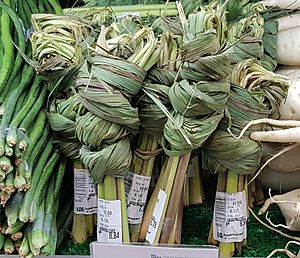Lemon grass facts for kids
Quick facts for kids Lemon grass |
|
|---|---|
 |
|
| Scientific classification | |
| Genus: |
Cymbopogon
|
| Species: |
citratus
|
| Synonyms | |
|
List
|
|
Lemon grass, also known as West Indian lemon grass, is a tropical plant. It comes from Maritime Southeast Asia but now grows in many warm parts of the world. You often see it sold as stems. Even though it can grow in some warmer places like the UK, it doesn't like frost and can't survive cold winters.
Contents
What Lemon Grass Looks Like
Lemon grass is part of the grass family. It has simple, bluish-green leaves that are long and thin. These leaves can grow to be about 18 to 36 inches (45–90 cm) long. Like other grasses, the veins in its leaves run in straight, parallel lines.
Where Lemon Grass Grows
Lemon grass first grew in Island Southeast Asia, also known as Malesia. It was brought to South Asia a long time ago. After World War I, lemon grass was also introduced to places like Madagascar, South America, and Central America. Now, it grows naturally in warm, tropical, and subtropical areas all over the world.
In its home regions, lemon grass has different names. In Indonesia and Malaysia, it's called sereh or serai. In the Philippines, people call it tanglad.
How People Use Lemon Grass in Cooking

Lemon grass is very common in the Philippines and Indonesia. Its strong-smelling leaves are often used in traditional cooking. For example, it's a key ingredient in dishes like lechon (roasted pig) and roasted chicken.
You can also dry the leaves and brew them into a tea. This tea tastes a bit like lemon juice but is mildly sweet, not sour. In Sri Lanka, lemon grass is called sera. It's used as a herb in cooking and for its essential oils.
In Thailand, lemon grass is known as takhrai. It's a very important ingredient in famous Thai soups like tom yam and tom kha kai. Fresh, thin slices of lemon grass stem are also used in a snack food called miangpla.
Traditional and Health Uses
The leaves of lemon grass have been used in traditional medicine for a long time. You can often find them in herbal supplements and teas.
What's Inside Lemon Grass
Lemon grass oil contains many natural chemicals. The most important one is citral, which makes up 65–85% of the oil. Other parts include myrcene, citronellal, citronellol, linalool, and geraniol. This oil can be separated from water using a process called distillation. The water left over, called hydrosol, is used to make skin care products like lotions and cleansers.
One of the chemicals, citronellol, is found in lemon grass. Studies have shown it might help lower blood pressure in rats. In one small study, a tea made from lemon grass was used to help treat oral thrush in people with HIV/AIDS.
Laboratory studies have also shown that lemon grass has properties that can protect cells, act as an antioxidant, and reduce inflammation.
Old Medicinal Practices
In the traditional medicine of the Krahô people in Brazil, lemon grass is believed to help with anxiety, sleep, and seizures.
In traditional medicine in India, the plant's leaves are used to help people feel more energetic, sweat more, and fight fevers or colds. The essential oil is used to help with digestion, calm the body, reduce pain, fight fevers, and act against bacteria and fungi.
How Lemon Grass Affects Insects
Beekeepers sometimes use lemon grass oil in special traps to attract swarms of bees. Lemon grass oil has also been tested to see if it can repel annoying stable flies, which bite farm animals.
See also
 In Spanish: Hierba de limón para niños
In Spanish: Hierba de limón para niños



